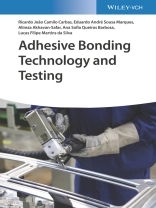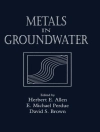Adhesive Bonding Technology and Testing
Comprehensive resource that provides insight into the purpose and design of experiments for adhesive bonding, joint design and strength prediction
This book provides support for those practicing and teaching adhesive bonding and enables them to understand and design laboratorial courses and experiments. To aid in reader comprehension and information retention, a selected set of problems with corresponding solutions is included, which helps readers to develop a deep understanding of the subject matter. Written by five highly qualified professionals in the field of adhesive bonding, sample topics covered in the book include:
- Practical demonstrations of adhesive bonding, plus discussion on the advantages and disadvantages of the technique
- Detailed laboratorial activities that pertain to adhesive bonding
- The manufacturing of defect-free bonded joints
- The effects of geometry and materials properties in adhesive joint testing, surface preparation, joint design, and strength prediction
This book is an essential resource for chemists, engineers, and students/instructors in related programs of study who wish to conduct better and more efficient experiments that pertain to adhesive bonding and related concepts.
Table des matières
Preface xi
1 Simple Practical Demonstrations 1
1.1 Importance of Loading Mode on Bonded Joint Performance 1
1.1.1 Introduction 1
1.1.2 Equipment 1
1.1.3 Materials 2
1.1.4 Safety Precautions 2
1.1.5 Experimental Procedure 2
1.2 Surface Treatments and Methods to Evaluate Surface Energy 6
1.2.1 Introduction 6
1.2.2 Equipment 7
1.2.3 Materials 8
1.2.4 Safety Precautions 8
1.2.5 Experimental Procedure 8
1.3 Stress Distribution Along the Overlap Length 12
1.3.1 Introduction 12
1.3.2 Equipment 13
1.3.3 Materials 13
1.3.4 Safety Precautions 13
1.3.5 Test Procedure 13
1.4 Visual Identification of Defects in Adhesive Joints 15
1.4.1 Introduction 15
1.4.2 Equipment 17
1.4.3 Materials 17
1.4.4 Safety Precautions 17
1.4.5 Test Procedure 17
1.5 Failure Analysis of Adhesive Joints 19
1.5.1 Introduction 19
1.5.2 Equipment 20
1.5.3 Materials 20
1.5.4 Safety Precautions 20
1.5.5 Test Procedure 21
2 Production and Testing 25
2.1 Bulk Specimens 25
2.1.1 Introduction 25
2.1.2 Adhesive Pouring Technique 25
2.1.3 Metallic Mold 26
2.1.4 Adhesive Application 30
2.1.5 Curing Procedure 31
2.1.6 Machining Procedure 33
2.1.7 Testing Procedure 35
2.2 Thick Adherend Shear Specimens 35
2.2.1 Introduction 35
2.2.2 Metallic Mold 36
2.2.3 Surface Treatment of Adherends 37
2.2.4 Geometrical Control Using Shims 40
2.2.5 Specimen Manufacture 41
2.2.6 Final Specimen Preparation 42
2.2.7 Testing Procedure 42
2.3 Fracture Mechanics Specimens 44
2.3.1 Introduction 44
2.3.2 Metallic Mold 48
2.3.3 Surface Treatment of Adherends 49
2.3.4 Adhesive Spacers 50
2.3.5 Specimen Manufacture 50
2.3.6 Final Preparation of Specimens 51
2.3.7 Testing Procedure 52
2.3.8 Data Reduction Schemes 53
2.4 Single-Lap Joint Specimens 56
2.4.1 Introduction 56
2.4.2 Surface Treatment of Adherends 56
2.4.3 Joint Manufacture 57
2.4.4 Final Preparation of Specimens 60
2.4.5 Testing Procedure 60
3 Laboratorial Activities and Report Examples 65
3.1 Effect of Surface Treatment on the Mechanical Behavior of Adhesively Bonded Joints 65
3.1.1 Introduction 65
3.1.2 Work Description 67
3.1.3 Materials 67
3.1.4 Experimental Work 67
3.1.5 Report 68
3.2 Effect of Adhesive Type and Overlap Length on the Failure Load of Adhesively Bonded Joints 79
3.2.1 Introduction 79
3.2.2 Work Description 83
3.2.3 Materials 83
3.2.4 Experimental Work 84
3.2.5 Report 84
3.3 Effect of Adhesive Thickness on the Failure Load of Adhesively Bonded Joints 97
3.3.1 Introduction 97
3.3.2 Work Description 98
3.3.3 Materials 99
3.3.4 Experimental Work 99
3.3.5 Report 99
3.4 Effect of Overlap Length on the Strength and Failure Mechanism of Composite Adhesive Joints 104
3.4.1 Introduction 104
3.4.2 Work Description 105
3.4.3 Materials 105
3.4.4 Experimental Work 105
3.4.5 Report 106
3.5 Modeling a Single-Lap Joint Using Finite Element Analysis and Cohesive Zone Modeling 117
3.5.1 Introduction 117
3.5.2 Work Description 117
3.5.3 Materials 117
3.5.4 Modeling Procedure 118
3.5.5 Report 118
3.6 Case Study in Joint Design for a Structural Automotive Application 139
3.6.1 Introduction 139
3.6.2 Report 139
References 163
4 Essay and Multi-choice Questions 165
4.1 Essay Questions 165
4.2 Multi-choice Questions 166
Solutions 187
Essay Questions — Example Answers 187
Multi-choice Questions — Solutions 190
Index 191
A propos de l’auteur
Ricardo João Camilo Carbas is a postdoctoral researcher at the Institute of Science and Innovation in Mechanical and Industrial Engineering and an invited lecturer at the Faculty of Engineering of the University of Porto. He has published 88 ISI papers on adhesive technologies.
Eduardo André Sousa Marques is an Associate Professor in the Department of Mechanical Engineering at the Faculty of Engineering of the University of Porto (FEUP) and a researcher at the Institute of Science and Innovation in Mechanical and Industrial Engineering, carrying out research on advanced joining processes of Porto. He has published 86 ISI papers on adhesive technologies.
Alireza Akhavan-Safar is currently a postdoctoral researcher in the Institute of Science and Innovation in Mechanical and Industrial Engineering. He obtained his Ph D in Adhesive mechanical characterization in 2017 from the Iran University of Science and Technology (Iran).
Ana Sofia Queirós Ferreira Barbosa is currently a postdoctoral researcher in Institute of Science and Innovation in Mechanical and Industrial Engineering. She obtained her Ph D in Reinforcement adhesives in 2017 and MSc in Material Science from the University of Porto (Portugal).
Lucas Filipe Martins da Silva is Full Professor in the Department of Mechanical Engineering at the Faculty of Engineering of the University of Porto (FEUP) and Director of the Integrated Master in Mechanical Engineering. He leads the Advanced Joining Processes Unit (AJPU) of the Institute of Science and Innovation in Mechanical Engineering and Industrial Engineering (INEGI) composed of approximately 40 members post-doc, doctoral students, and master students.












